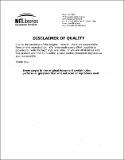| dc.contributor.advisor | Scott Burles. | en_US |
| dc.contributor.author | Fakhouri, Onsi Joe, 1983- | en_US |
| dc.contributor.other | Massachusetts Institute of Technology. Dept. of Mathematics. | en_US |
| dc.date.accessioned | 2006-05-15T20:26:09Z | |
| dc.date.available | 2006-05-15T20:26:09Z | |
| dc.date.copyright | 2004 | en_US |
| dc.date.issued | 2004 | en_US |
| dc.identifier.uri | http://hdl.handle.net/1721.1/32733 | |
| dc.description | Thesis (S.B.)--Massachusetts Institute of Technology, Dept. of Physics; and, (S.B.)--Massachusetts Institute of Technology, Dept. of Mathematics, 2004. | en_US |
| dc.description | Includes bibliographical references (leaves 85-87). | en_US |
| dc.description.abstract | In this thesis we use gravitational lensing statistics to constrain the QSO luminosity function at a variety of redshifts. We present a theoretical discussion of gravitational lensing statistics and illustrate how high resolution QSO imagery can be used to constrain the QSO luminosity function. We then discuss the selection and observation of the 1073 QSO exposures in our sample. The sample covers a redshift range of 0.7<z<5.5 and may include up to 10 multiply imaged QSOs. We discuss the QSO analysis pipeline developed to compute the gravitational lensing probabilities of each QSO and then present the constraints on the QSO luminosity function and compare them to results in the literature. Our results confirm the suspected fall off in the high-end QSO luminosity function slope at high redshift and agree with modern literature results. We conclude with a brief discussion of improvements that can be made to our analysis process. | en_US |
| dc.description.statementofresponsibility | by Onsi Joe Fakhouri. | en_US |
| dc.format.extent | 87 leaves | en_US |
| dc.format.extent | 4673795 bytes | |
| dc.format.extent | 4677885 bytes | |
| dc.format.mimetype | application/pdf | |
| dc.format.mimetype | application/pdf | |
| dc.language.iso | eng | en_US |
| dc.publisher | Massachusetts Institute of Technology | en_US |
| dc.rights | M.I.T. theses are protected by copyright. They may be viewed from this source for any purpose, but reproduction or distribution in any format is prohibited without written permission. See provided URL for inquiries about permission. | en_US |
| dc.rights.uri | http://dspace.mit.edu/handle/1721.1/7582 | |
| dc.subject | Physics. | en_US |
| dc.subject | Mathematics. | en_US |
| dc.title | Constraining the QSO luminosity function using gravitational lensing statistics | en_US |
| dc.title.alternative | Constraining the Quasi-Stellar Object luminosity function using gravitational lensing statistics | en_US |
| dc.type | Thesis | en_US |
| dc.description.degree | S.B. | en_US |
| dc.contributor.department | Massachusetts Institute of Technology. Department of Mathematics | |
| dc.contributor.department | Massachusetts Institute of Technology. Department of Physics | |
| dc.identifier.oclc | 56728351 | en_US |
